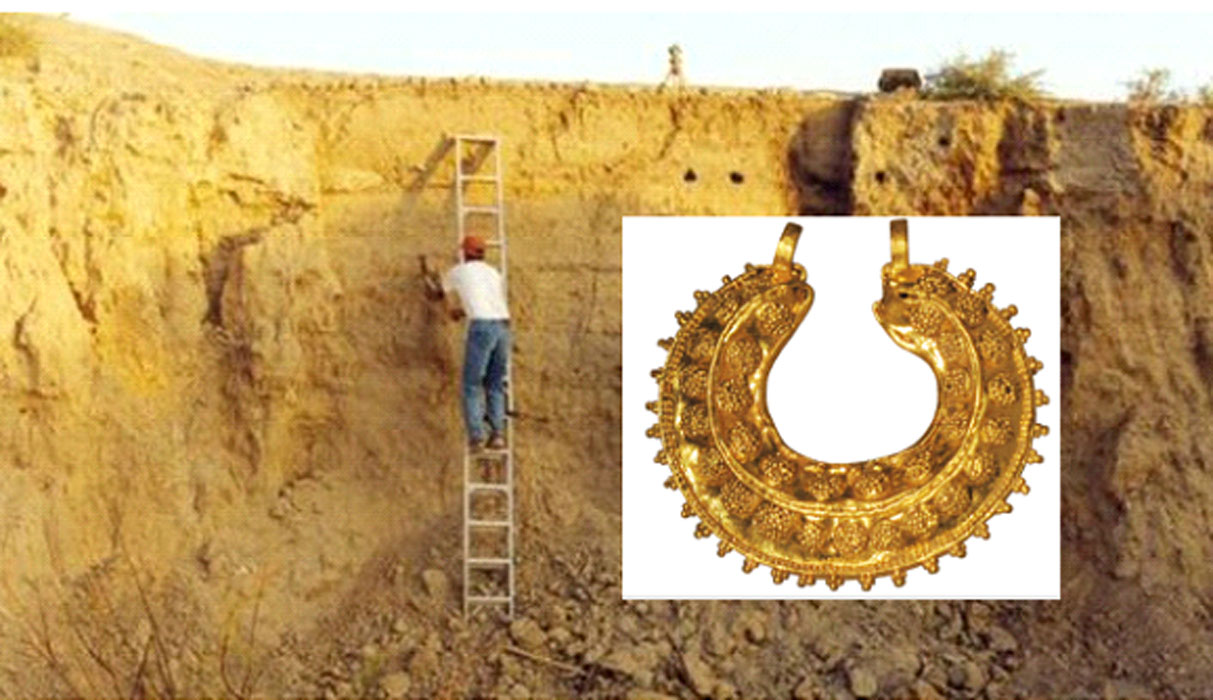3,600-Year-Old Town of Treasures Excavated in Gaza
A rich trading town dating back about 3,600 years has been under excavation in the Gaza Strip on the coast of the Mediterranean Sea. Archaeologists have uncovered stunning gold jewelry, scarabs and Cypriot pottery in the town, Tell el-Ajjul, which was on one of the ancient world’s major trade highways.
Various peoples fought major wars along the route over the millennia, though it appears the people of Tell el-Ajjul were peaceful.
William M. Flanders Petrie first excavated the town from 1930 to 1934 and found large amounts of pottery, gold objects and other jewelry, many of which are on display in the British Museum.

Gold falcon earring jewelry found at Tell el-Ajjul (studentreader.com)
Ha’aretz reports (subscription required), that recent excavations have shown that there were more than 500 years of trade between Tell el-Ajjul and other people around the Mediterranean. More than 200 potsherds of a type rarely found outside Cyprus have been uncovered from the ruins, indicating close ties between the people of the town and the island.
“I was aware of the Cypriot imports from Petrie’s excavations, but when I realised the actual amount of Cypriot imports, I came to the conclusion that Tell el-Ajjul was a trading centre with tight connections to Cyprus, sanctioned by the Egyptian overlord,” Gothenburg University Professor Peter Fischer, head of excavations, told Haaretz.
After arriving in Tell el-Ajjul, Cypriot pottery and copper and bronze items were redistributed in the Levant, including in Transjordan, Ha’aretz says.
Fischer told the Israeli newspaper he believes the great wealth of the tell was from trade surpluses because there are few natural resources in the area except, perhaps, from the fruits of agriculture, including olive oil and wine.
Fischer said he thinks Tell el-Ajjul was the main trading town in the area and it may have had a monopoly on commerce with major trade centers in Cyprus from the Middle through Late Bronze ages. Imports of rich items from Syria, the Jordan Valley, Egypt and Mycenae are evidence of the importance of the trading post from about 1650 to 1300 BC, Ha’aretz says.

The site of Tell el-Ajjul (Google Earth)
The tell is situated on the trade route, one of the world’s oldest, called the Via Maris or King’s Highway that connected North Africa with the Levant. It was a site of battles from the time of ancient Egyptian rule, conquest by Philistia, through Alexander the Great’s conquest, the Crusades and up to nearly modern times with Napoleon’s excursions into the region, says Ha’aretz, adding that the list is not exhaustive.

The famous Via Maris road running between the empires of the Fertile Crescent to the north and east and Egypt to the south and west (saffold.com)
It is unknown who ruled the trade town. Experts have speculated that during the Middle Bronze Age the rulers were sovereign kings or governors, Ha’artez says, dispatched from the Egyptian Hyksos capital of Avaris in the Nile Delta. But later, around 1500 BC when the Hyksos Dynasty was overthrown, it seems Egyptian governors of the 18 th and 19 th dynasties may have assumed control.
“Fischer believes Tell el-Ajjul is identical with Sharuhen, where according to Egyptian sources the Hyksos fled after being expelled from Egypt by Pharaoh Ahmose I,” Ha’aretz states.
Fischer said: “Most of the more than 1300 scarabs from Tell el-Ajjul were locally produced and represent trading goods which one can find everywhere in the Levant, including Transjordan. However, there are also genuine Egyptian scarabs at Tell el Ajjul.”
There was a large amount of deluxe pottery at Tell el-Ajjul, most of it imported from Cyprus, one of the major pottery manufacturers of the Eastern Aegean. It appears the people of Tell el-Ajjul traded Canaanite jars with wine, oil and incense for the luxury pottery of Cyprus, Ha’aretz states.
Unfortunately, says the article in Ha’aretz homes are now being constructed on the ruins of the ancient town, which threatens efforts to do proper excavations and may even destroy it. The population of Gaza is 1.87 million as of 2015. The people live on 141 square miles, so space is cramped, and they don’t have enough money to build high-rise apartment buildings.
Fischer told Ha’aretz he fears the entire tell may be destroyed by the new construction. And excavations of the tell were halted in 2011 because of Egyptian and Israeli restrictions.
"There are new houses everywhere on the tell. In consequence, I am very pessimistic that Tell el-Ajjul can be saved for future generations. Believe me, I have tried,” he told the newspaper.
Top image: Main: Excavating at Tel el-Ajjul, Gaza. Credit: Peter M. Fischer. Inset: Gold crescent shaped earring jewelry found at Tell el-Ajjul.
By Mark Miller



















